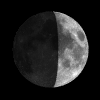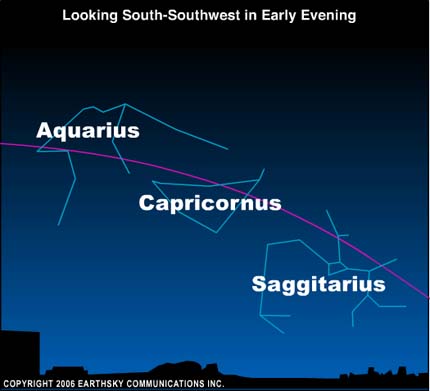Courtesy of EarthSky
A Clear Voice for Science
www.EarthSky.org

 Today’s sky chart shows the constellations of the Zodiac that are up after nightfall on these October evenings. We got this question: “I’m having a difficult time being able to recognize the constellations of the Zodiac . . . do you have any advice?”
Today’s sky chart shows the constellations of the Zodiac that are up after nightfall on these October evenings. We got this question: “I’m having a difficult time being able to recognize the constellations of the Zodiac . . . do you have any advice?”
Yes . . . we can recommend a few things.
First, the zodiacal constellations are the backdrop for the pathway of the sun around our sky each year, and of the moon for every month. Since the sun’s path lies within these constellations, you know you can look for them along the approximate path that the sun follows during the day – from east to west across the sky.
Another thing you can do is to locate the Summer Triangle high to overhead in your southern sky. This Thursday evening, October 14, 2010, the Summer Triangle stands way above the first quarter moon. Tonight, the moon sits in front of the constellation Sagittarius. Tomorrow night, the moon will have moved in front of the constellation Capricornus. Although the moon’s glare can make it difficult to see a particular constellation of the Zodiac, it can help you to locate this constellation.
Once the moon drops out of the evening sky in late October and November, remember to look for the constellations of the Zodiac swinging from east to west beneath the Summer Triangle – that is, if you live in the northern hemisphere. As seen from the southern hemisphere, these same constellations appear very high in the sky, instead of close to the horizon.
How dark is your night sky? If you are looking from the city or suburbs, you might not be able to pick out these patterns in the sky. After all, these patterns were identified by people who did not have electric lights!
Finally, do you have a good chart? There are wonderful sky charts on the market today. You might try looking at the shop pages of Sky and Telescope magazine. Be sure you find something that specifically refers to “constellations” and not just “stars,” if that is what you are after. Some charts are designed for people with telescopes, but there are also good books and charts aimed at beginners.
In short, look low in the south – well below the Summer Triangle – to find the constellations of the Zodiac swinging from east to west across the October evening sky.
![]() Written by EarthSky
Written by EarthSky
Astronomy Picture of the Day from NASA/JPL
U.S. Naval Observator Astronomical Information center
The York County Astronomical Society